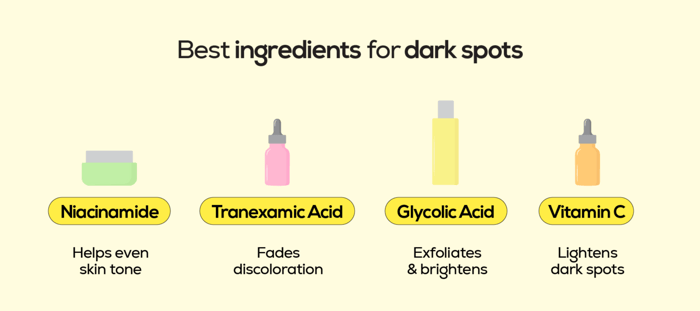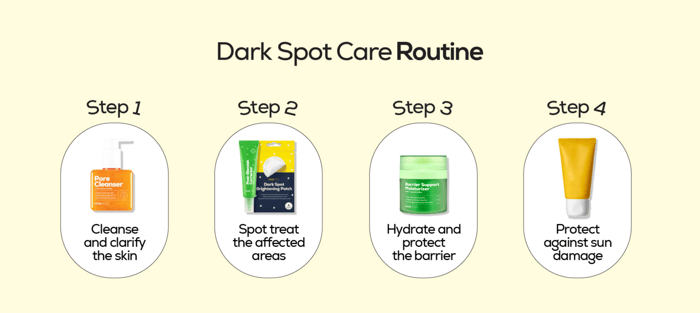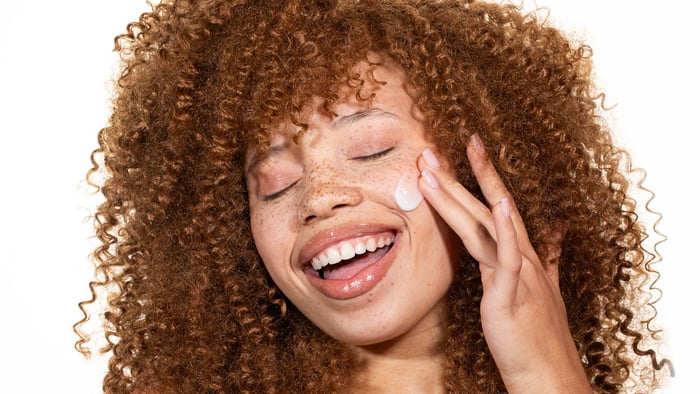Lots of treatments in the market for dark spots carry some pretty intimidating-sounding ingredients including Retinoids and Acids (like Glycolic Acid or Tranexamic Acid). And we aren’t exactly all cosmetic chemists or dermatologists to know exactly what’s safe for our particular skin types and concerns.
So it can seem daunting to seek out a routine or treatments to help clear up dark spots or post-blemish marks on our own. This is where a little bit of research comes in, but don’t worry we can help break it down so it’s easier to understand what you need to look for.
What should I look for in dark spot treatments?
There are tons of ingredients that are great for helping to fade the look of dark spots and post-blemish marks. And not all are harsh on the skin either. You don’t exactly have to go for the strongest product to get results, you just have to make sure that the ingredients mesh well with your skin and are targeting dark spots specifically.
Here are a list of some great ingredients you should be looking out for:

Niacinamide
By now you’ve probably seen this ingredient everywhere, whether in your own routine or in your favorite derms’ videos. Niacinamide is that one star ingredient in tons of different formulas for its super diverse benefits. It helps with everything from skin barrier repair to hydration to dark spot care.
According to this study, Niacinamide helps with hyperpigmentation by inhibiting melanosome transfer. In basic terms, this means that Niacinamide blocks the movement of melanosomes (pigment cells) which contribute to hyperpigmentation.
And in some skincare formulations Niacinamide is typically combined with a couple of other brightening agents to boost its brightening effects.
Tranexamic Acid
This one you might not be all that familiar with but it’s a great ingredient to include in your arsenal. Sure, it might sound a little scary but it’s not exactly what you might think. Unlike other typical acids in your skincare, Tranexamic Acid is not an exfoliant and won’t sensitize your skin like other acids can.
Tranexamic Acid works by reducing melanin production to further help prevent and reduce hyperpigmentation. But, not all post-blemish marks are darker in color. Lighter skin tones typically deal with post-blemish marks that are pink or red in color. Tranexamic Acid is also known to help reduce this type of redness as well.
Glycolic Acid
Amongst one of the gentlest exfoliating acids, Glycolic Acid helps renew the skin’s surface to help even skin tone. Glycolic Acid functions by breaking down dead skin cells to reveal brighter, smoother skin underneath.
So, where you might avoid stronger exfoliants if you have sensitive skin, Glycolic Acid can serve as a gentler option. As an exfoliant, Glycolic Acid helps even skin tone but also helps reduce the look of fine lines and reduces rough skin texture.
Vitamin C
A popular ingredient for treating hyperpigmentation is Vitamin C. But, not all Vitamin C’s are created equal. Some people can experience irritation from Vitamin C, but it all depends on the type you’re using. A type of Vitamin C that may be more irritating is called L-Ascorbic Acid. But, if you have had a bad experience with Vitamin C before, that doesn’t mean you have to avoid it altogether. You just have to find a version that's gentle enough for your skin.
Some versions of Vitamin C that are safe for sensitive skin include: Magnesium Ascorbyl Phosphate (MAP), Tetrahexyldecyl Ascorbate, Sodium Ascorbyl Phosphate, and Ascorbyl Glucoside. These tend to be gentler on the skin while still delivering brightening benefits.
These are just some of the great brightening ingredients available to sensitive skin types dealing with discoloration. Others to look out for include: Kojic Acid, Alpha Arbutin, and Licorice Root.
Dark Spot Care Routine:
Now that you understand what ingredients to look out for, you can build your routine to help address any discoloration:

Step 1: Cleanser
As per usual, any skincare routine starts with a cleanser. There are also tons of different types of cleansers with star ingredients that help address a variety of skincare concerns.
For example, our Pore Cleanser includes star ingredients like Niacinamide and Salicylic Acid to help target pores, but also helps with tone and texture.
Step 2: Treatment
Here is where you can start to incorporate any dark spot-targeting products. This could be your dark spot serums, patches, or creams. Here are some Hanhoo products you can try out to target dark spots:
Post-Blemish Corrector
Made with 3% Niacinamide and 2% Tranexamic Acid, our Post-Blemish Corrector helps fade the look of post-blemish marks, including both dark spots and red spots. The lightweight gel-serum can be used daily, absorbs quickly, and wears great under makeup (no pilling here!).
Dark Spot Brightening Patch
This microneedle patch utilizes dissolving microneedles to help deliver a combination of 2% Niacinamide, Green Tea, Hyaluronic Acid, and Ascorbyl Glucoside (a form of Vitamin C) straight to the spot. Compared to the Post-Blemish Corrector, we recommend using the Dark Spot Brightening Patch 3 to 4 times a week for at least two weeks.
Step 3: Moisturizer
You’ll want to keep your skin barrier working at an optimal level to help protect from external factors that can make discoloration worse. You can do this with a barrier-boosting moisturizer to keep the skin smooth and looking healthy.
Our Barrier Support Moisturizer has multiple Ceramides and 6 types of Hyaluronic Acid to help protect the barrier and restore hydration.
Step 4: Sunscreen
Lastly, you need sunscreen. No matter how many dark spot treatments you use, if you’re not applying sunscreen daily then these treatments are not really going to do a good job on clearing up dark spots. Without sunscreen, UV exposure will just continue to damage the skin and darken the hyperpigmentation already present.
Final Tips…
When looking for a dark spot treatment, always look out for products that combine a couple of different brightening ingredients to get the best results. And, If you are still not too sure if your skin will tolerate a certain treatment, you can always spot test the product first.




